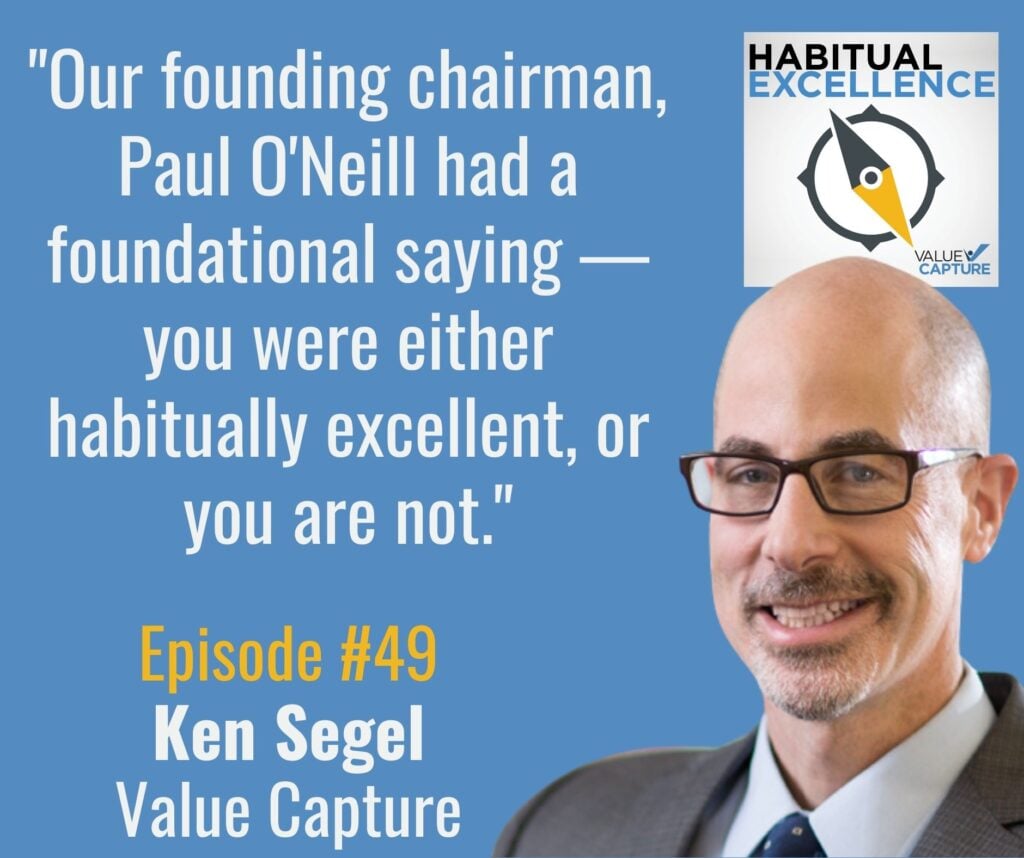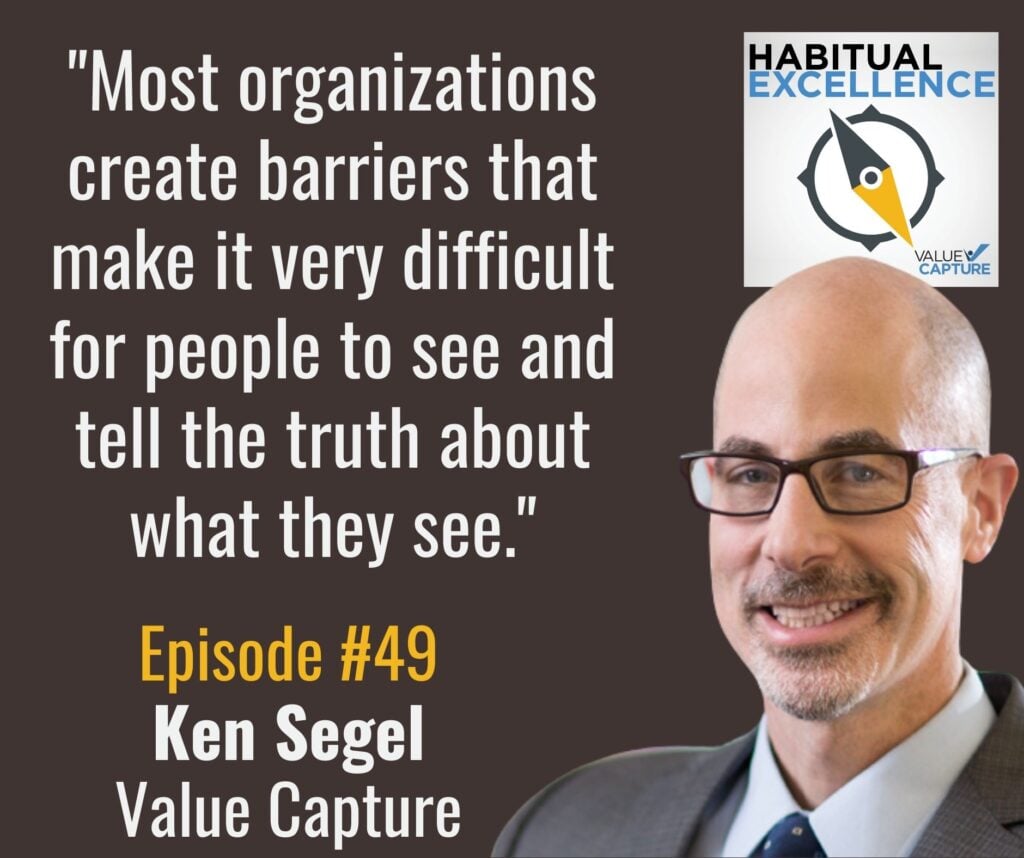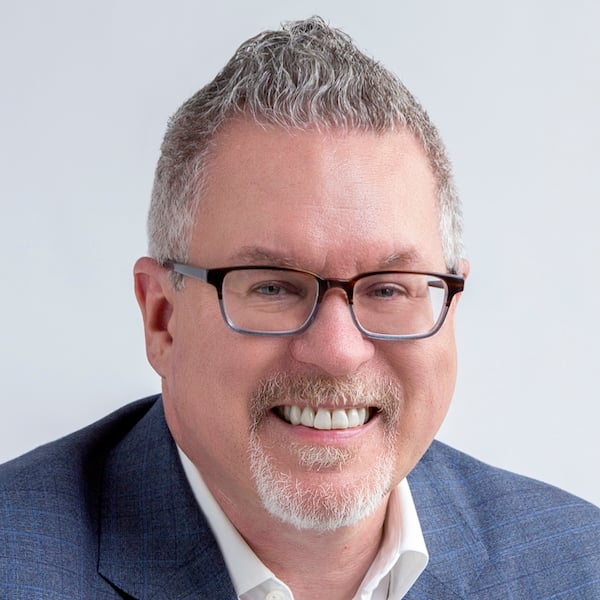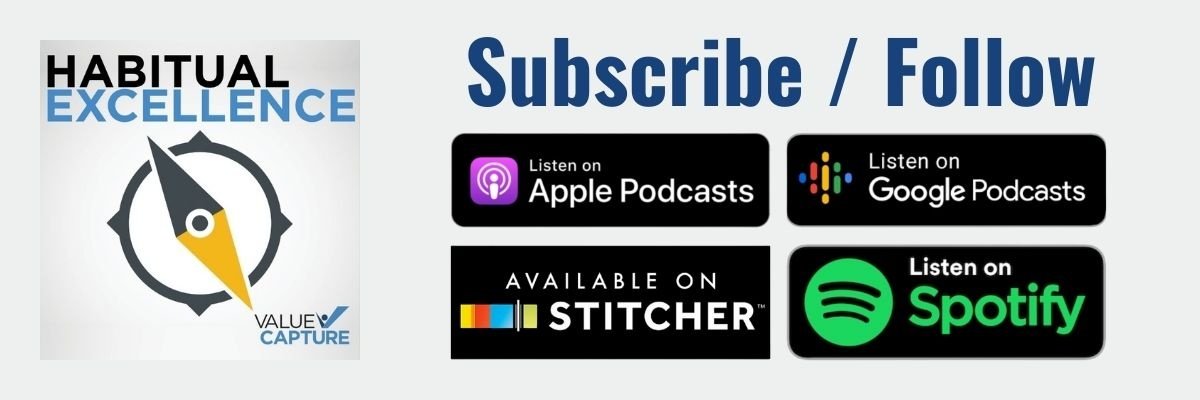Listen:
Scroll down for a transcript, video, how to subscribe, and more
Notes:
Welcome to Episode #49 of Habitual Excellence, presented by Value Capture.
Today's episode is another video essay from Ken Segel, the CEO of Value Capture. In his last video, Ken talked about the importance of the "Shingo Principles," starting with "Create Constancy of Purpose." This time, Ken talks about the principle of "Create Customer Value."
"Ultimately, value must be defined through the lens of what a customer wants and is willing to pay for. Organizations that fail to deliver both effectively and efficiently on this most fundamental outcome cannot be sustained long term."
Value Capture is very honored to be a Licensed Affiliate of the Shingo Institute. As the only affiliate focused on healthcare, Value Capture has bolstered its proven, principles-based framework to help healthcare leaders guide their organizations toward operational excellence.
Watch the Episode:
Quotes:


!["What do [patients] really need? Let's ask them in a really deep way. Let's look at the data. Let's go and observe at the clinics in our EDs, in our acute settings, and at their homes and in their community centers."](https://www.valuecapturellc.com/hubfs/Imported_Blog_Media/Ken-Segel-Habitual-Excellence-3-1024x858.jpg)
Podcast Main Page:
Click to visit the main Habitual Excellence podcast page.
Subscribe:
To make sure you don't miss an episode, be sure to subscribe today! Please rate and review the podcast.
Transcript:
Mark Graban (2s):
Welcome to Habitual Excellence, presented by Value Capture. This podcast, and our firm, is all about helping you and your organization. Achieve habitual excellence. Be a one unifying focus, one value based structure and one performance system. In other words, it's about helping you capture dramatically more value through achieving perfect care and perfect safety for patients and staff. To learn more about value capture and our services visit www.valuecapturellc.com. Hi, Welcome to episode 49 of Habitual Excellence. Today is another audio essay by our CEO, Ken Segel.
Mark Graban (44s):
He's going to be talking about the Shingo guiding principle called "create customer value." You may have heard episode 46, where he talked about the Shingo principle of "create constancy of purpose." Today, again, it's Ken Segel. You can find links and show notes and more on our website at valuecapturellc.com/he49.
Ken Segel (1m 9s):
Again, everyone I'm Ken Segel, the CEO of Value Capture. We support transformational health system leaders, and we're proud to be a certified affiliated the Shingo Institute. Today I get to share with you a little bit about what a principle is and again illustrate with one of the 10 powerful principle Shingo principles that serve as the basis for building a sustainable culture of enterprise excellence. Over several months, my colleagues and I are providing illustrations of all 10 Shingo principles. In a previous episode, I had the chance to illustrate "create constancy of purpose." Today, I have the opportunity to teach about the principle "create value for the customer"
Ken Segel (1m 49s):
in the Shingo movement. We posit that leaders' fundamental role is to bring these principles to life and the culture of the organization. So it's important to understand what they are. So what is a principle? A principal is a foundational rule that governs consequences, whether we want to believe in the principle or not. I want to repeat that -- whether we want to believe in it or not, it is operating in the background and when our actions, which we call behaviors, align with it, good things happen. And when our actions don't, bad things happen. We say principles are timeless and universal. That means they apply everywhere, always to everyone in their evidence.
Ken Segel (2m 29s):
That means they can be discovered through research to prove it. Stephen R Covey, as I said last time, taught us that values governor actions, but principles govern the consequences of our actions. So we're really talking a lot about consequences of our actions and our behaviors. And as I shared last time, I really good analogy to understand this is gravity. You don't have to believe in gravity for it to be governing consequences. If you jump from a height without protection, you will fall and may be injured. If you instead choose the stairs is a way to get down because you're aware of gravity as universal force for more likely to be safe.
Ken Segel (3m 10s):
So remember this, you can go principles or the gravity of organizational performance. So to illustrate, let's go to the principle I'm talking about today. Create value for the customer. In a reminder, the 10 Shingo principles are divided into three categories. This one, like constancy of purpose, falls into the Enterprise Alignment category. Create value for the customer is defined as "ultimately value must be defined through the lens of what a customer wants and is willing to pay for organizations that fail to deliver both effectively and efficiently on this most fundamental outcome cannot be sustained long-term." Now I want to pause and sadly, it is important to acknowledge the truth that because of how healthcare is financed, there are many organizations that have sustained themselves as ongoing concerns for quite a while, while perhaps not doing an ideal job with this principle.
Ken Segel (4m 6s):
I will point to signs. However, the customers are wielding more and more power over the fate of healthcare organizations than previously, consumers and patients. So perhaps the universality this principle is asserting itself even more fundamentally in our sector. But there is a deeper point to be made here. The organizational excellence principles are about striving for habitual excellence, for what is possible, for the best of us. So that's where we're going to keep our lens, not what we can get away with, but what brings out the best of us, what level of performance as possible. And we so desperately need it from health care, which is so important to every single human being.
Ken Segel (4m 50s):
Another point to acknowledge about this particular definition. Sometimes healthcare audiences have trouble with the phrase what a customer will pay for because healthcare is about more than money. So I always say, don't get hung up there, legitimate as the definition is, and it is defendable. But instead, in healthcare, if it's easier for you think of this as the need to relentlessly obsessively, continuously work to provide more and more of what the people you serve deeply value and continuously and obsessively worked with eliminate what they don't value and isn't necessary.
Ken Segel (5m 30s):
When a leader creates a powerful attachment to this universal truth for the organization, makes it an anchoring point for everyone every day, our hypothesis about principles, governing consequences, poses that good things will happen. And if they don't, if creating value for the customer isn't present in all of our behaviors and minds every day, less positive outcomes for the organization will occur. So let's test that hypothesis and illustrate the concept of consequences with examples of leaders living and perhaps not living as well, the principle of creating value for the customer. So we'll start with an example that those of us who have a certain age are familiar with -- the rise of foreign car brands led by Toyota, especially the Japanese brands and the 1970s, the quality revolution that Toyota brought and the sort of leadership framework that they figured out that was allowing them to produce cars of much higher quality at lower initial costs and lower operating costs for the customer.
Ken Segel (6m 33s):
They were sort of putting half of the resources in and getting twice the value out from a customer perspective. It was quite the revolution. So from a customer perspective, we're getting higher quality. We're getting fewer breakdowns, less repair costs, less initial costs. Sounds good, not a shock that market share rose dramatically. People started to buy in great quantities. In companies that had been perhaps taking the customer for granted, not innovating and as deep measurable, what am I willing to pay for kind of way lost market share and what's threatened to survive and sometimes more than one cycle of this. So now let's move to healthcare.
Ken Segel (7m 14s):
I recently spoke with a senior vice president of one of our more prestigious health systems underlying how fundamentally and urgently the system had been working to make access to their services as frictionless and instant as possible, anchored in digital, given the growing power they are seeing from consumers who can quickly assess where they are likely to have their healthcare meds fastest with the least and with the least trouble and the best experience in a very competitive market. This system is seeing the numbers move based on whether they are getting rid of all of the waste associated with getting access to healthcare or not. And this system is moving to catch up with their customer's expectations as a result, with some greater urgency and a bit of worry, I'd say.
Ken Segel (7m 60s):
So it's positive consequences they believe if they're driving the principle and negative consequences, if they're not. Now consider, if for decades, this system had been truly deeply driven by this principle. They might already have been far ahead of their competitors and delivering to their patients and perspective patients services that the patients were deeply valued in their patients would be willing to pay more, pay them more for than their competitors. That kind of loyalty we get from our customers when we do that consistently. So when digital did end up bringing patient power to the forefront recently, how much further ahead could they have been with word of mouth, with the capabilities to continue to deliver continuously better for their customers as well, be greatly enhanced.
Ken Segel (8m 47s):
So further gains ahead here. It's helpful to mention one of the key enabling concepts for the enterprise alignment grouping of principles: Think long-term. When you think long term, driving these principles deeply into the organizations, you can see the value even more clearly, and you can see the long term massive payoff, even more clearly. Another example at another health system: a new leader who's deeply anchored in principles-driven leadership, lots of transformation, going to their customers, the patients they serve, and asking what they valued and would pay for. They were really surprised by part of the results they found out.
Ken Segel (9m 29s):
People didn't want to be hurt during their healthcare. Check. They might've expected that. But they also deeply focused on healing, patients did, in wanting to get back to their jobs as fast as possible. Getting back to their jobs as fast as possible. That was not in the health systems leaders' minds. So the lens changed from narrow length of stay numbers and dollars to key measures of quality and function in time and successful return to work with no harm as the anchor pursued for everyone in the system every day. So the results of combining these principles and others? Five years later, every major quality safety customer and employee indicator had improved by more than 50%.
Ken Segel (10m 14s):
The system footprint had also grown substantially versus regional competitors for, because they are focused on value to the customer. By the way, they had the best financial years ever. There is a coda to this story. However, these same leaders were also deeply and appropriately humbled and ashamed by their uninsured patients telling them that not only do they not value getting dragged to court over unpaid bills, it was ruining their financial health and hurting their physical health. The news media had to be a part of getting leaders to hear this message. They did hear it ultimately and reflected and have realized another crucial point about these principles. They have to be observed with consistency everywhere every day.
Ken Segel (10m 57s):
You can't pick and choose. And even more than that, you've got to go look into the corners of your organization, where the principles might not be true for every one of your people and every one of your customers and change it and spread the learnings as results. Our founding chairman, Paul O'Neill had a foundational saying you were either habitually excellent, or you are not. The last hard example brings me to another beautiful illustration of a healthcare leader over a different, large regional delivery system. Helping his team apply the principle of create value for the customer to a very uninsured population. Traditionally in this health system, like many, uncompensated care had always been viewed as a cost to be endured a number to be minimized via almost exclusively financial strategies and written off this leader changed the focus to truly creating value to the customer.
Ken Segel (11m 51s):
What does this uninsured population among, which are many of our most frequent and sickest patients? What do they really need? Let's ask them in a really deep way. Let's look at the data. Let's go and observe at the clinics in our EDs, in our acute settings and at their homes and in their community centers. And they built systems of support for their uninsured patients anchored in getting them to supporting connections to community resources that they needed and guiding their journeys through the health system and a more value added dignified way and building their health, maintaining skills as well, their patient's health maintenance skills.
Ken Segel (12m 32s):
And guess what better serving these customers in a way that the customers deeply valued that literally made them better when you subtracted the cost of doing it from the financial savings, this became the single biggest improvement in the finances of the health system that year, the single biggest chunk of improvement on the financial side. And by the way, on the service side, it created an awful lot of pride in the workforce, and joy. So this brings us to another enabling concept here that this leader used: see reality. As Shingo himself noted, most organizations create barriers that make it very difficult for people to see and tell the truth about what they see.
Ken Segel (13m 18s):
So we, as leaders have to see what's happening in the lives of those that we serve. We have to see what they experienced. We have to see and feel what they value matched up against what they get from us today. So what do your customers value? How does it match with what they're getting from you today? How would you know? What opportunities do you think you have with your team to embed this universal principle into everyone's work every day, starting with your own. It's been a privilege to share a little bit more with you about the Shingo principles today, including today's focus on creating value for the customer. I hope you'll continue to learn more about the principles and especially what enduring legacy of success you can create as a leader, by leading with them.
Ken Segel (14m 3s):
And please do reach out to us if we can help. We can. And we'd love to thanks a lot.
Mark Graban (14m 8s):
Thanks for listening to Habitual Excellence, presented by Value Capture. We hope you'll subscribe to the podcast and please also rate and review it in your favorite podcast, directory or app to learn more about value capture and how we can help your organization on this journey to habitual excellence, visit our website www.valuecapturellc.com.

Written by Mark Graban
Mark Graban has served healthcare clients since 2005. Mark is internationally recognized as a leading author and speaker on Lean healthcare. His latest book is "The Mistakes That Make Us: Cultivating a Culture of Learning and Innovation."


Submit a comment